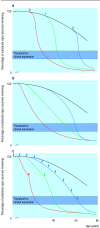Science, medicine, and the future: Parkinson's disease
- PMID: 9924061
- PMCID: PMC1114782
- DOI: 10.1136/bmj.318.7179.311
Science, medicine, and the future: Parkinson's disease
Figures


References
-
- Golbe LI. Genetics of Parkinson’s disease. In: Ellenberg JH, Koller WC, Langston KW, editors. Etiology of Parkinson’s disease. New York: Marcel Dekker; 1995. pp. 115–140.
-
- Polymeropoulos M, Lavedan C, Leroy E, Ide SE, Dehejia A, Dutra A, et al. Mutation in the α-synuclein gene identified in families with Parkinson’s disease. Science. 1997;276:2045–2047. - PubMed
-
- Krüger R, Kuhn W, Muller T, Woitalla D, Graeber M, Kosel S, et al. Ala30Pro mutation in the α-synuclein in Parkinson’s disease. Nature Genet. 1998;18:106–108. - PubMed
-
- Kitada T, Asakawa S, Hattori N, Matsumine H, Yamamura Y, Monoshima S, et al. Mutations in the parkin gene cause autosomal recessive juvenile parkinsonism. Nature. 1998;392:605–608. - PubMed
-
- Gasser T, Müller-Myhsok B, Wszolek Z, Oehlmann R, Calne DB, Bonifati V, et al. A susceptibility locus for Parkinson’s disease maps to chromosome 2p13. Nature Genet. 1998;18:262–265. - PubMed
Publication types
MeSH terms
Substances
LinkOut - more resources
Full Text Sources
Other Literature Sources
Medical
